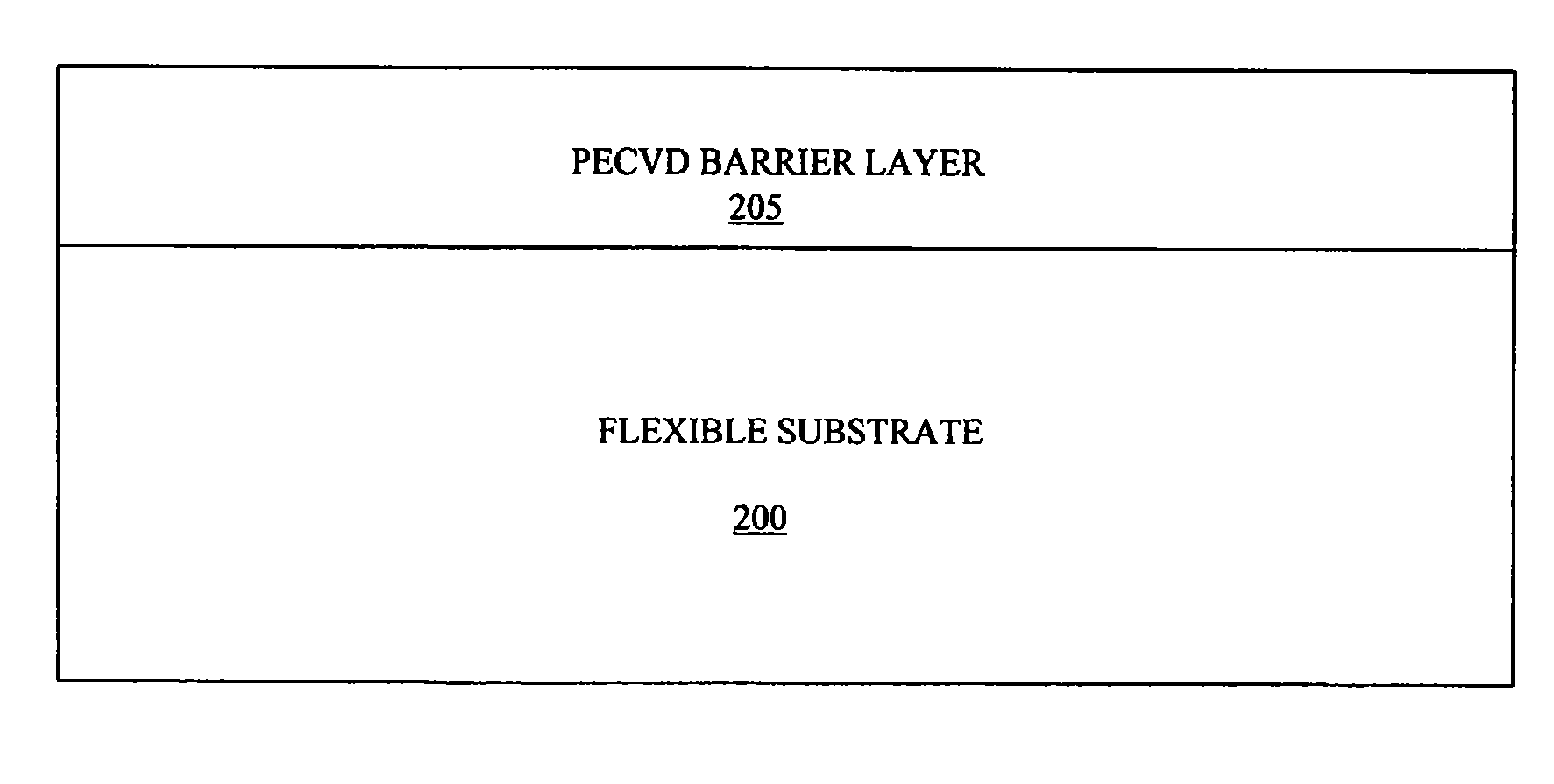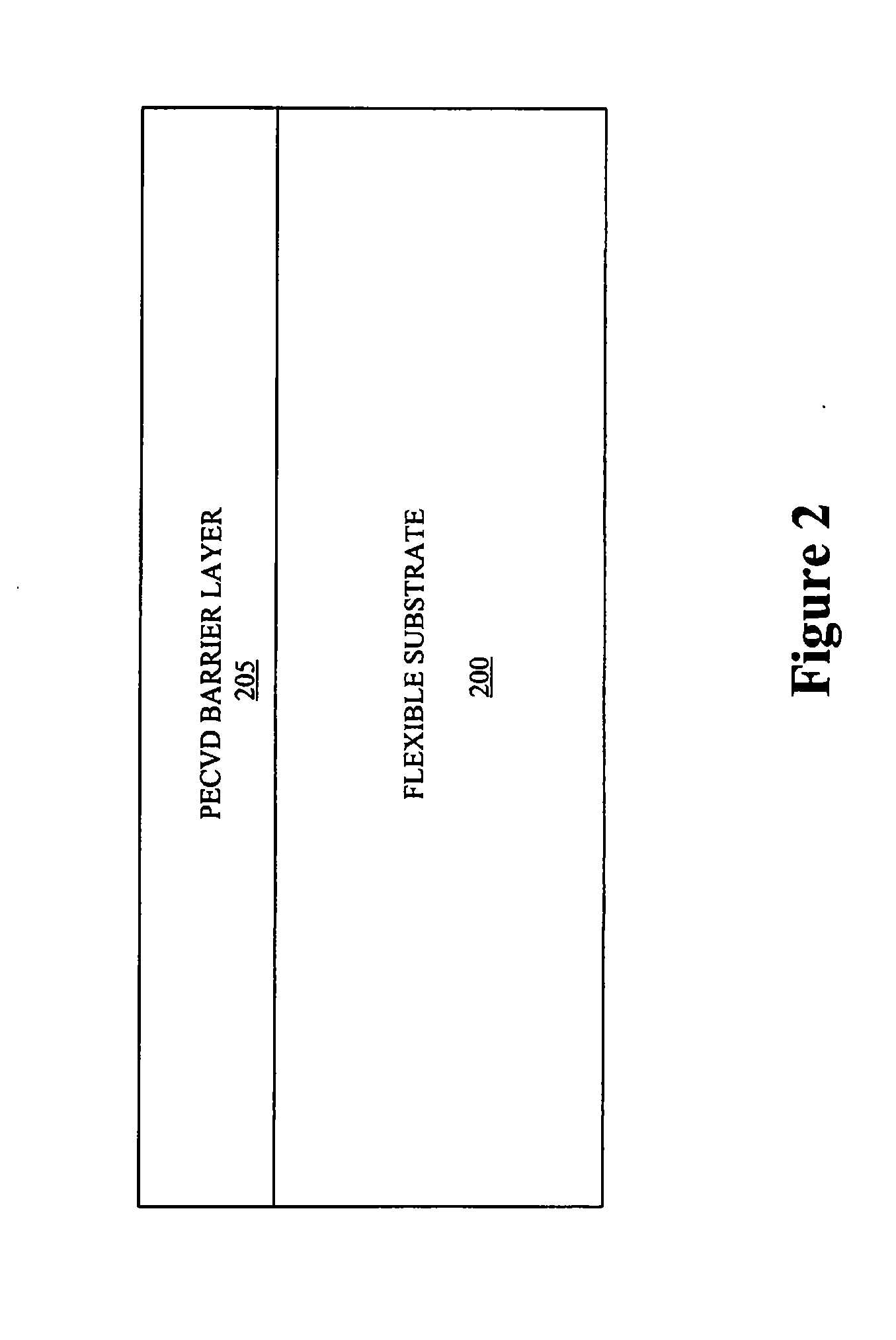Roll-To-Roll Plasma Enhanced Chemical Vapor Deposition Method of Barrier Layers Comprising Silicon And Carbon
a technology of chemical vapor deposition and plasma, which is applied in the direction of water-setting substance layered products, synthetic resin layered products, transportation and packaging, etc., can solve the problems of increasing the overall processing time required, reducing the production volume of the system, and not being able to continuously process by batch, etc., and achieves a high level of protection
- Summary
- Abstract
- Description
- Claims
- Application Information
AI Technical Summary
Benefits of technology
Problems solved by technology
Method used
Image
Examples
examples
[0047]The following examples are presented to better illustrate the coated substrates and methods of the present invention. However, these examples are intended to be illustrative and not to limit the present invention. In the examples, barrier coating deposition has been performed utilizing a single- and / or dual-asymmetric Penning discharge plasma source that operates in the medium frequency range. The temperature of the rollers in the deposition chamber has been maintained at 18-25° C. Tables 1 presents some of the physical properties of the barrier layers formed according to the present examples and FIGS. 4, 5 and 6 present some of the optical properties of the barrier layers.
examples 1
[0048]Barrier coating deposition has been performed at a plasma power range of 300-500 W (Table 1). The deposition process has been conducted introducing a silicon-carbon containing precursor, namely trimethylsilane ((CH3)3SiH), in the deposition chamber or a reactive gas mixture comprising trimethylsilane ((CH3)3SiH), and argon (Ar) with gas flow rate ratios of Ar / ((CH3)3SiH) up to 2.5 at a pressure range of 20-30 mTorr (Table 1). Barrier coatings have been deposited on polyethylenterephtalate (PET) film material. The thickness of the deposited barrier layers is typically around 0.75 μm. Barrier coatings contain silicon (Si), carbon (C), oxygen (O) as contaminant and hydrogen (H) in compositional ratios of Si / C=0.60-0.65 and O / Si=0.075-0.10, i.e. the material can be classified as hydrogenated silicon carbide based on the structural unit SiC:H (Table 1, FIG. 3—solid line). Barrier layer has a low water vapor transmission rate (WVTR), in the range of 10−3-10−2 g·m−2d−1, as it has bee...
examples 2
[0049]Barrier coating deposition has been performed at the power range of 250-300 W (Table 1). The deposition process has been conducted introducing a reactive gas mixture in the deposition system comprising silicon-carbon containing precursor, namely trimethylsilane ((CH3)3SiH), argon (Ar) and oxygen (O2) with gas flow ratios of Ar / ((CH3)3SiH)=1.0-1.5 and O2 / ((CH3)3SiH)=0.5-1.25 at a pressure range of 30-50 mTorr (Table 1). In this example, the barrier layer has been deposited on both PET and PEN flexible substrates. The thickness of the deposited barrier is typically in the range of 1.5-2.0 μm. Barrier coating contains silicon (Si), carbon (C), oxygen (O) and hydrogen (H) in compositional ratios of Si / C=0.95-1.10 and O / Si=0.35-1.0, i.e. the material can be classified as hydrogenated silicon oxycarbide based on the structural unit SiOC:H (Table 1, FIG. 3 dash and dotted lines). Barrier layers have low water vapor transmission rate (WVTR), in the range of 10−3 g·m−2d−1, as it has be...
PUM
| Property | Measurement | Unit |
|---|---|---|
| temperature | aaaaa | aaaaa |
| dielectric constant | aaaaa | aaaaa |
| light transmittance | aaaaa | aaaaa |
Abstract
Description
Claims
Application Information
 Login to View More
Login to View More - Generate Ideas
- Intellectual Property
- Life Sciences
- Materials
- Tech Scout
- Unparalleled Data Quality
- Higher Quality Content
- 60% Fewer Hallucinations
Browse by: Latest US Patents, China's latest patents, Technical Efficacy Thesaurus, Application Domain, Technology Topic, Popular Technical Reports.
© 2025 PatSnap. All rights reserved.Legal|Privacy policy|Modern Slavery Act Transparency Statement|Sitemap|About US| Contact US: help@patsnap.com



